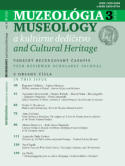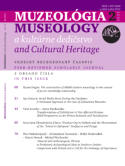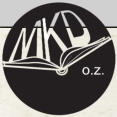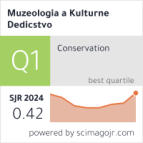

MUZEOLÓGIA
MUSEOLOGY
a kultúrne dedičstvo
and Cultural Heritage

News
Journal Muzeológia a
kultúrne dedičstvo -
Museology and Cultural
Heritage:
SJR 2024: 0,424 (Q1)
Museology SJR rank: 8/83 (Q1) Conservation SJR rank: 11/103 (Q1)JIF WoS 2023: 0,6
JCI WoS 2023: 1,28, Q1 ESCI: 49/411 (Q1)New issue
Muzeológia a kultúrne
dedičstvo 2/2025
online New volume Studia Museologica Slovaca, vol. 8 (2024) online New volume Populačné štúdie Slovenska 17 (2024) onlineNew book
P. Tišliar (ed.). Osobnosti uměleckoprůmyslového muzejnictví (2025) online
Contents 2/2025
Title: The construction of Middle Eastern museology in the context of power–knowledge relationship
Abstract: The museum has been an important instrument in the construction of the past since the nineteenth century. It has been a
symbol of modernization as an institution built in all capitals in Europe from the nineteenth century. In terms of the Middle East, the
museum has represented an institution that reflects development within the framework of modernization movements. Developing
regional museums in this context has not only been used as a means of imperialist annexation but also, for local rulers, a means of
attaining Western standards of modernity. In the first case, the construction of the museum is about revealing the construction of the
past and emphasising the role played by the ancestors of Western power. In this study, the power–knowledge relationships behind the
development of the museum as an institution in the Middle East is examined.
Authors: Oytun Doğan1
Publication order reference:
1 Marmara University Cumhuriyet Museum and Art Gallery, Istanbul, Turkey, e-mail: oytun.dogan@marmara.edu.tr, https://orcid.org/0000-0002-4180-5708
Source: Muzeológia a kultúrne dedičstvo, year: 2025, vol.: 13, issue: 2, pages: 5–20.
Key words: museum; Middle East; archaeology; memory; power–knowledge
Language: English
online full-text PDF
doi: 10.46284/mkd.2025.13.2.1
Title: Social Media Boost During the Pandemic: A Statistical Approach to the Case of Lithuanian
Museums
Abstract: As a disease prevention measure during the COVID-19 pandemic, museums worldwide stopped accepting visitors and
increased their digital activities as an alternative. This study examines the long-term impact of COVID-19 on social media usage by
Lithuanian museums from 2019 to 2021. The research questions were: “Have levels of social media usage by museums increased
since the beginning of the COVID-19 pandemic? If so, how has the content changed?” Statistical and content analyses of Facebook
use by Lithuanian national and state museums from 2019 to 2021 revealed that social media posts increased. Quantitative analysis
showed seasonal variations in activity, with a significant increase in September of each year. Qualitative analysis categorized posts
into invitations to visit, publicising activities, interacting with visitors, announcements and statements. It was found that the museums
mainly used social media for unidirectional information dissemination rather than interactive communication.
Authors: Aya Kimura1
Publication order reference:
1 Department of Human Sciences, Obihiro University of Agriculture and Veterinary Medicine, Inada-cho, Obihiro, Hokkaido 080-8555, Japan, e-mail:
akimura@obihiro.ac.jp, https://orcid.org/0000-0002-4109-5355
Source: Muzeológia a kultúrne dedičstvo, year: 2025, vol.: 13, issue: 2, pages: 21–41.
Keywords: museum communication; pandemic; social media; Lithuania
Language: English
online full-text PDF
doi: 10.46284/mkd.2025.13.2.2
Title: Transformations of Exhibitions in War-Affected Ukraine: 2024 Perspectives on Art-Driven
Inclusion and Socialization
Abstract: This article explores the transformation of exhibition practices in Ukraine amidst the ongoing conflict, focusing on the period
up to 2024. It examines the extensive damage to cultural monuments and museum collections caused by Russian aggression and
highlights the adaptive strategies of Ukrainian cultural institutions. The study addresses the shift towards decolonisation, with
museums increasingly prioritising Ukrainian and international artworks over Russian cultural displays. It also discusses the role of
contemporary art forms, such as photography, in resisting and responding to the challenges of war. The paper also considers the
emerging emphasis on accessibility for people with disabilities, driven by the growing number of people affected by war injuries. In
addition, it highlights the importance of art therapy as a tool for psychological support, aiding in the emotional recovery of those
affected by trauma. Through these lenses, the article highlights the resilience and innovation of Ukrainian cultural practices in the face
of adversity.
Author: Yulia Ivashko,1 Aneta Pawłowska2
Publication order reference:
1 Kyiv National University of Construction and Architecture, Ukraine, e-mail: yulia-ivashko@ukr.net, https://orcid.org/0000-0003-4525-9182
2 Department of Art History, University of Lodz, Poland, e-mail: aneta.pawlowska@uni.lodz.pl, https://orcid.org/0000-0003-2847-4403
Source: Muzeológia a kultúrne dedičstvo, year: 2025, vol.: 13, issue: 2, pages: 43–63.
Keywords: Ukraine; cultural heritage; art therapy; inclusion; decolonization
Language: English
online full-text PDF
doi: 10.46284/mkd.2025.13.2.3
Title: Woodcarving in Podhale and the Phenomenon of the “School in Zakopane” Sculptures and
Design
Abstract: Zakopane woodcarving is perceived in a kind of suspension between ethnographic tradition (folk art) and artistic modernity.
For almost 250 years now, the patriotic aspect of Podhale’s tangible culture has been an inseparable context of its evaluation. For the
Polish people, Zakopane and the Tatra Mountains are a phenomenon which is permanently inscribed in the cultural heritage of their
nation. Based on the contemporary state of research and current methodologies, the article aims to revise the methods of researching,
interpreting and exhibiting Zakopane sculptures, both historical and contemporary.
Authors: Katarzyna Chrudzimska-Uhera1
Publication order reference:
1 Institute of Art History, Cardinal Stefan Wyszyński University in Warsaw, Poland, e-mail: kasia.chrudzimska.uhera@gmail.com, https://orcid.org/0000-0001-
6283-4682
Source: Muzeológia a kultúrne dedičstvo, year: 2025, vol.: 13, issue: 2, pages: 65–78.
Keywords: Zakopane; Polish art of the nineteenth and twentieth centuries; woodcarving; national style; folk art
Language: English
online full-text PDF
doi: 10.46284/mkd.2025.13.2.4
Title: Natural and Anthropogenic Threats to Prehistoric Archaeological Sites in Southern Jordan:
Comparison with Poland and a Call for the Exchange of Experiences
Abstract: Jordan’s rich archaeological heritage, encapsulating crucial chapters of human history, faces unprecedented threats from
both natural and anthropogenic factors. This article elucidates the various challenges besieging Jordan’s historical sites, ranging from
climatic alterations to uninhibited urban expansion and intensified agricultural activities. Furthermore, it casts a spotlight on the
detrimental impacts of mining activities, underscoring the urgent need for integrated conservation strategies. By fostering a symbiotic
relationship between scientific research and practical conservation efforts, we advocate for a proactive approach to safeguard
Jordan’s irreplaceable treasures for future generations, thereby fostering sustainable tourism and empowering local communities. The
article also posits that community education and the promotion of sustainable tourism stand as vital tools in this pressing endeavour,
beckoning a wider appreciation for Jordan’s affluent history and vibrant culture, while ensuring the endurance of its monumental
legacy for ensuing generations.
In the face of escalating threats for a large number of archaeological sites, fostering international collaboration is paramount. The
article explores the potential of forging ties with Polish researchers, who bring a rich background of experience in the meticulous
conservation and management of archaeological heritage. By engaging in a vibrant exchange of experiences and knowledge as well
as innovative protective methodologies, there is an avenue to enhance the robustness of preservation strategies in place. This
collaborative discourse not only promises fresh perspectives and solutions but also opens doors to capacity building through training
and educational programmes dedicated to fragile archaeological relicts.
Authors: Piotr Kołodziejczyk,1 Mohammad Tarawneh,2 Bellal Abuhelaleh,3 Marek Nowak,4 Michał Wasilewski5
Publication order reference:
1Jagiellonian University in Kraków, Institute of Archaeology, Department of History, Gołębia 11 str, 31-007 Kraków, Poland, e-mail: pkolodzi@uj.edu.pl,
https://orcid.org/0000-0001-6374-8663
2 Al-Hussein Bin Talal University, Petra College for Tourism and Archaeology, Wadi Musa, Jordan, Ma’an, Postal Code: 71111, mohnaram_tara@yahoo.com,
https://orcid.org/0000-0002-1217-6092
3 Al-Hussein Bin Talal University, Petra College for Tourism and Archaeology, Wadi Musa, Jordan, Ma’an, Postal Code: 71111, e-mail:
bellal.abuhelaleh@gmail.com, https://orcid.org/0000-0003-4365-7670
4 Jagiellonian University in Kraków, Institute of Archaeology, Department of History, Gołębia 11 str, 31-007 Kraków, Poland, e-mail: marekiauj.nowak@uj.edu.pl,
https://orcid.org/0000-0001-7220-6495
5 Jagiellonian University in Kraków, Institute of Archaeology, Department of History, Gołębia 11 str, 31-007 Kraków, Poland, e-mail:
michal.wasilewski@uj.edu.pl, https://orcid.org/0000-0001-8173-2403
Source: Muzeológia a kultúrne dedičstvo, year: 2025, vol.: 13, issue: 2, pages: 79–101.
Keywords: archaeological heritage; Poland; Jordan; protection
Language: English
online full-text PDF
doi: 10.46284/mkd.2025.13.2.5
Articles (Abstracts)

Full-text version
DOI:10.46284/mkd.2025.13.2.0
ISSN 1339-2204
eISSN 2453-9759
EV 1/22/EPP
Vol. 13 (2025), No. Is. 2



























